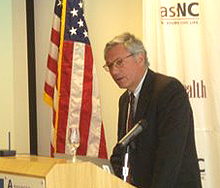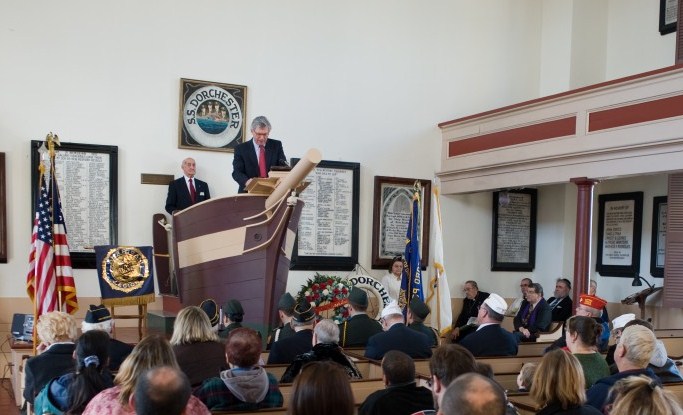 This is Mayor Lang’s New Year’s Eve speech at the Seamen’s Bethel on 31 January, 2011.
This is Mayor Lang’s New Year’s Eve speech at the Seamen’s Bethel on 31 January, 2011.
Good evening citizens of New Bedford, Mayor Elect Mitchell, New Bedford First Lady Marguerite “Gig” Lang, and clergy. Union Baptist Choir – thank you.
Today we conclude the first year of the second decade of the Twenty-first Century. Tonight is the twelfth time I have climbed the steps to this ship’s pulpit here at the Seamen’s Bethel to give an address to the congregation (six New Year’s Eves and six Four Chaplains ceremonies). These addresses have also been viewed through the eye of the camera and conveyed to the people of the City.
The Seamen’s Bethel, which was built in 1832, has hosted thousands of religious and civic ceremonies over the past 179 years. The sermons and lectures given at these ceremonies have dealt with the most joyous and the most sorrowful events.
As the Thirty-Seventh Mayor of the City of New Bedford, I am deeply honored and humbled to speak once again in this historic building.
New Year’s Eve is a time to reflect on the past year, on time that has passed by. The concept of time is based upon the period it takes for the earth to revolve around the sun. Three hundred sixty-five days, twenty-four hours a day, sixty minutes to an hour, sixty seconds to a minute, divided into seven-day weeks, around a calendar that consists of twelve months, each approximately four and a half weeks. Every four years an additional day is added to make three hundred sixty-six days to accommodate the slightly irregular orbit of the earth.
While time is ever present, we seldom reflect upon it moment by moment. New Year’s Eve, though, is one day that we all focus upon time. Today we look back at this past year and recall the good and try to forget the bad. We remember those who have left our lives and pray for them and ourselves. We value our life experiences and all of those who are in our lives – our families, our spouses and children, our friends, neighbors and fellow citizens.
Tonight, we think back to how we spent previous New Year’s Eves. We think of world events that were taking shape. We think of specific locations and whom we spent the time with. Pangs of nostalgia and melancholy drift through our thoughts. However, before the past begins to dominate, we begin looking forward to a new year. A fresh start. An opportunity to begin anew.
Upon reflection we vow to change for the better. No matter who we are. No matter how perfect we think we have been, we resolve to improve.
For some of us, this process of reflection and resolution is complicated, and takes a significant period of time and thought. For others, we don’t dwell on the constant ticking of the clock. We say a prayer for those who have passed, we appreciate those who are here, and we vow to be better people this coming year.
While we know that New Year’s Eve is the pathway to a bright future. It is always interesting to look back at periods in New Bedford’s history to find the strong foundation that built our City and allows it to persevere.
Recently while driving through Buttonwood Park, I observed a monument in great detail that I had driven by without notice hundreds of times before. It is a monument that I believe symbolizes where our City has been and where it is going.
The monument is located in the circular drive on Fuller Memorial Parkway which runs through the center of the park. It was erected on September 4, 1914, one year after our most famous statue, the New Bedford Whaleman’s Statue, was dedicated on June 20, 1913, outside of the New Bedford Free Public Library.
The Whaleman’s Statue was dedicated quote: “In honor of the whalemen whose skill, hardihood and daring brought fame and fortune to New Bedford and made its name known in every seaport around the globe.” It clearly was dedicated to a period in time when New Bedford was the energy capital of the world and is a statue that commemorates that great era.
In 1914, George D. Barnard, a man who was born in New Bedford in 1846, one year before the city was founded, and 14 years after this Bethel was built, donated the Buttonwood Park monument to the City of New Bedford.
Mr. Barnard, who as a young adult settled in St. Louis, became a very wealthy and famous businessman and entrepreneur. He never forgot his New Bedford roots.
In 1911 he received a letter from the principal and the children at the Fifth Street grammar school in New Bedford, which he had attended asking for a donation to help decorate the school. He generously responded to that request, and also at that time decided that he would donate a monument to his beloved City.
The purpose of the monument was not only to memorialize the grandeur of the whaling era, but also to look forward to New Bedford’s emerging industrial age and its future.
Just as we are tonight, Mr. Barnard was viewing New Bedford through a New Year’s Eve type of lens – surveying the past, taking account of the present, and looking towards the future.
The Barnard monument to New Bedford is absolutely magnificent in its design and creation. It depicts the origin of New Bedford’s greatness, which is its location, and bond to the sea. It displays the courageous faces of the men and women who built the most unique and dynamic port the world has ever seen. It rises towards the sky, 20 feet high, commemorating the creative energy of a people who went from dominance in whaling to prominence in worldwide manufacturing. Almost a century after this monument was erected, the symbolization for New Bedford and its future is as relevant today as it was the day that Mr. Barnard conveyed this gift to his fellow citizens of New Bedford.
The sculptor of the monument was George Julian Zolnay. He explained in vivid detail the significance and meaning of this tremendous granite and bronze artistic triumph. As they did then, his words ring true today:
“I was commissioned by George D. Barnard of St. Louis, a successful capitalist and businessman and a native of New Bedford, to make a monument to be erected in one of the parks of that City, which should be typical of her growth and industries. Such is the purpose of the work in hand.”
He went on to explain his work: “Art, perhaps more than anything else, must make a lasting record of the civilization of which it is contemporary. Just as the art of Greece and Italy did. The sculptor’s efforts in striving to do this are not the expression of himself alone, but of the civilization which surrounds him. Unless able to give this expression to his work, the artist fails in his mission. In the last analysis the triumph of a civilization is its art and by the art of their day all periods of history are judged.”
“The finished monument is 12 feet six inches at the granite base. At this base, the waves of the sea wash the worn rocks, and above stand figures nearly life size, cut in two large blocks, which when set up will be joined as one stone. On one side, the figures typify a whaleman about to go to sea, his eldest son clinging to him as if longing or expecting to accompany him, and the whaleman’s wife, her baby in her arms, clinging to her boy and bidding both good-bye. The features of these figures are strongly chiseled and were modeled from models of the hardy New England stock of New Bedford whaleman. On the other side of the monument, a group stands which typifies the tragedy of the past – the old seaman about to throw the life line, the terrified woman looking from the cliff upon the storm tormented sea, and mistily beyond, in the storm, masts and sails.”
“Then from this virile beginning, so poetically, and yet so powerfully conceived, rises the strong stone shaft upon which New Bedford’s modern industrial success is established. The figure above is historic, of bronze, eight feet and a half high. It is a symbolic figure, because in New Bedford there are other industries beside the cotton industry. The sculptor, therefore, has chosen the figure which throughout the history of art has indicated mechanical toil, labor among machinery, of whatever kind it may be, – the artisan, with the anvil beside him which symbolizes, in the poetry of sculpture, great givings of strength, muscle-hardening toil, the din of giant achievements.”
He continues: “The anvil should not be seen as a mere anvil of iron; the bevel gear as only a gear of steel; the artisan as only a hammer of metal; the electric motor as only a motor driving wheels. The anvil has a voice when the artisan hammers upon it, through which sounds the mingled voices of a thousand weavers; the bevel gear whirls when the great machines are running; the electric motor flashes the spark of modern scientific achievement, driving the wheels of industry. He who asks, “It is only an anvil, – what has an anvil or a bevel gear to do with the cotton mills?” has no spirit of poetry in him, and shows himself incapable of rising to the genius of the sculptor, who thus in so modern a spirit has symbolized in Homeric terms the spirit of New Bedford’s greatness.”
He concluded by saying: “The dream-conceptions, chiseled in granite and moulded in bronze, will make Buttonwood Park a Mecca of art, and will carry to the children of this generation and to their children’s children the fire romantic conception of a great mind of the past and present of the Whaling City.”
On New Year’s Eve 2012 I can attest that the monument, and its symbolism, has stood the test of time. New Bedford has had a storied past and an exciting present of which we are all a part, but our future beginning this evening will be just as historic, equally exciting and dynamic.
To our citizens, to the old year with pride and thanks. To the new year, my best wishes for a happy, healthy 2012 for you and your families. To our troops, a special prayer for them and their families.
God Bless New Bedford. Thank you for allowing me to serve as your Mayor.
 New Bedford Guide Your Guide to New Bedford and South Coast, MA
New Bedford Guide Your Guide to New Bedford and South Coast, MA








